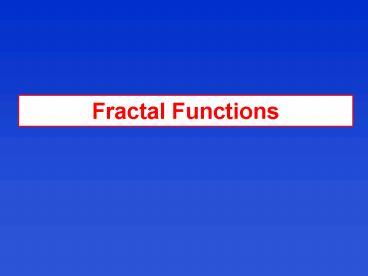Fractal Functions PowerPoint PPT Presentation
1 / 26
Title: Fractal Functions
1
Fractal Functions
2
The concept of self affinity
Generically, the self similarity properties of
fractal sets and fractals measures induce some
very intricate singular behavior. The spatial
distribution of these singularities has been
studied via the multi-fractal formalism. One
could think of using the same kind of methods in
order to study very irregular functions such as
rough surfaces, stock exchange data, ID component
of the velocity in a turbulent flow, signals
obtained from spectroscopy, 1/f noise, i.e. the
functions that do not have any characteristic
scale and which are highly singular. These
functions can be classified as Fractals functions
in the sense that their graphs are fractal in R2
.
3
The self affinity property characterizes the
(fractal) sets which are invariant under affine
transformations Mandelbort, 1982 Petigen
Saupe, 1987 Voss. 1987, 1989 Dubuc et al.,
1989 Edgar, 1990.
In R2, it means that the considered set is
similar to itself when transformed by anisotropic
dilations. A particular case of self affinity is
self similarity which implies isotropic
transformations. We will say that a function
is self-affine when its graph is a self affine
set.
A set is said to be a self similar if it
the union of disjoint subsets S1., SR that can
be obtained from S with a scaling, translation
and rotation.
4
(No Transcript)
5
(No Transcript)
6
If f is a stochastic process, the identity holds
in law for fixed and x0. The exponent H is
called the Hurst Exponent. The graph of the
function is self-similar only if the Hurst
exponent is H 1 (the graph is then invariant
under some isotropic dilations). Let us note that
if H lt 1, then f is not differentiable and that
the smaller the exponent H, the more singular f.
The Hurst Exponent indicates how irregular the
function f is. Let us present some classical
examples of self-affine functions.
7
Examples
Let us consider the triadic Cantor set and
the homogeneous measure on this set. We define f
0,1 ? 0,1 as the distribution function of
, i.e.,
8
(No Transcript)
9
Figure 2
10
Where ltgt represents the mean value. The variance
of such a process is
11
are stationary. Indeed the correlation function
12
depends only on t-s. For H1/2, we recover the
fact that the increments of the Classical
Brownian motion are independent. For any other
value of H, the increments are correlated. From
equation (3) one gets
13
We will use the wavelets corresponding to the
successive derivatives of the Gaussian
function. Let us define as
Its Fourier transform is
14
(No Transcript)
15
Analysis of Singularities with Continuous wavelet
Transform
Local regularity and Holder exponent of a
distribution
We have seen how the strength of a singularity
can be described by an exponent called local
Hurst exponent or Holder exponent.
Let us give a more rigorous definition of a
Holder exponent
Definition 2.
The holder exponent h(x0) of a distribution f at
the point x0 is the greatest h so that f is
Lipschitz h at x0, i.e., there exists a constant
C and a polynomial Pn(x) of order n so that for
all x in a neighbor hood of x0 we have
16
(No Transcript)
17
Indeed, for instance, the Holder exponent in
the neighbor hood of 0, thus its Holder exponent
at xo 0 is greater than 2! In the following, we
will consider distributions whose singularities
are not oscillating. Basically, when one
differentiates (integrates) such a distribution,
the Holder exponent is decreased (increased) by
1. Thus, for instance, the Heaviside Function
corresponds to h(0) 0 and its derivative,
the Dirac distribution corresponds
to h(0) -1. The function has a Holder
exponent h(0) ½ and its derivative, the
distribution a Holder exponent
h(0) - ½.
18
Remark
Wavelet analysis of local Holder regularity
19
(No Transcript)
20
For the sake of simplicity, we slightly change
the definition of the wavelet transform by
multiplying its expression by the factor
In this definition we assume that f is no longer
restricted to L2(R,dx) it can be any
distribution. The relation (12) then becomes
21
Thus, around a given point x0, the faster wavelet
decreases when the scale a goes to 0, the more
regular f is around that point. This result can
be summed up in a single theorem which has been
proved independently by Jaffard 1989 and by
Holschneider Tchamitichian 1990
22
Theorem 1.
i.
ii.
then f is Lipschitz at x0
23
(No Transcript)
24
Detection and identification of singularities
with the wavelet transform. Wavelet transform
modulus maxima and maxima lines
25
Definition 3.
26
We call maxima line, any connected curve in the
space-scale half plane made of modulus maxima.
We illustrate in figure 5. The considered
function is .
Thus the modulus maxima of the wavelet transform
allows us to study in very efficient way the
isolated singularities of a distribution f. In
the case of fractal distribution, these
singularities are not isolated. However, as we
can see that in most cases, the same analysis can
be carried out.

